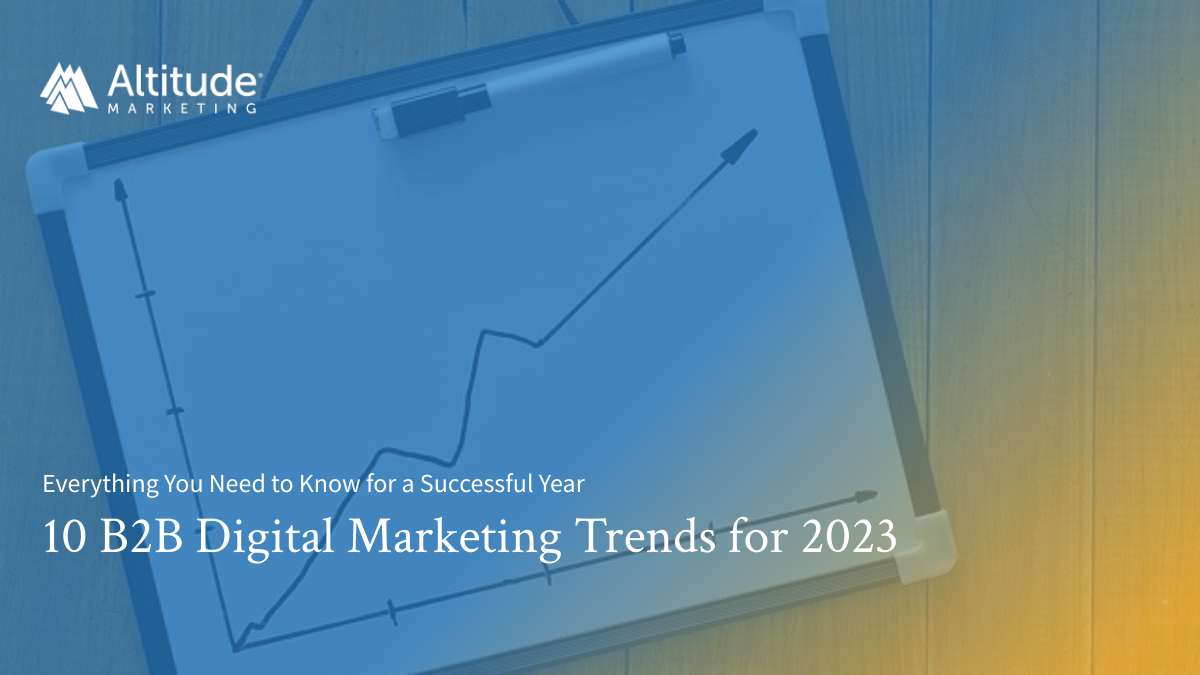B2B digital marketing includes any online marketing efforts that are aimed at other businesses. Whether you are looking to sell, inform or entertain, your business can utilize B2B digital marketing to elevate your brand and convert leads. And one way to make an impact is by following proven trends. In this blog, we share 10 B2B digital marketing trends for 2023 that are here to stay.
Digital marketing is an always-changing arena. Innovation peaks around every corner, and it can be tempting to fall in line with every new flashy trend you come across. But if you spread your digital marketing strategy too thin, you risk spending a lot of money on subpar results. That’s why it’s important to know which B2B digital marketing trends are worth focusing on – especially as you start making plans for the second half of this year and 2023.
We’ve compiled a list of 10 trends that deserve your attention:
- The analytics landscape is shifting
- Ad networks are moving away from Google
- Influencers are for everyone
- The line between UX and SEO is blurred
- Antitrends are on the rise
- Fundamentals still matter
- Utilize interactive content
- Video is still relevant
- User-generated content is growing
- Leverage digital marketing agencies

10 Trends B2B Digital Marketers Need to Know for 2023
1. The Analytics Landscape Is Shifting
Google announced it’s retiring Universal Analytics on July 1, 2023. Universal Analytics, also known as “UA” or “Google Analytics,” is what many B2B marketers use to measure engagement.
Google is replacing UA with Google Analytics 4 (GA4), which is a more integrated, almost app-style analytics platform. While UA is great for tracking website engagement, GA4 does so much more. It works well with marketing sites, eCommerce sites, native apps and web apps to provide you with a comprehensive overview of how users interact with your whole brand.
Why is the change happening? There’s increasing pressure on advertisers due to privacy regulations and changes within products. Browsers are blocking more and more ads, and third-party cookies are slowly becoming obsolete. This is making it harder for advertisers to measure how their brands are performing. This is putting a greater emphasis on organic content and SEO, because if B2B marketers can’t target users, they need a way to lead the users to them. It also drives the need for boutique networks and partners.
2. Ad Networks Are Moving Away From Google
The pandemic has changed the way B2B marketers advertise on Google. On the Google Search side of things, call-per-click (CPC) has run wild since 2020, and there are no signs of costs going down. Since it’s challenging for B2B marketers who advertise services and high-end solutions to see a good return on investment (ROI), many are abandoning Google.
The Google display network isn’t doing any better. Bot traffic is through the roof (95% of clicks), and so without good targeting, users won’t see your ads.
Meanwhile, B2B marketers are going to other networks for their advertising needs, including:
- Microsoft Advertising (formerly known as Bing Ad)
- Choozle
- StackAdapt
LinkedIn is especially useful for B2B marketers because its job-title targeting is solid. It enables you to build audiences you can’t get anywhere else. And while buying audience data is a premium ($40 cost-per-click is common), it’s worth the price because the targeting is so much better than Google’s.
3. Influencers Are for Everyone
Influencer marketing has exploded in popularity over the years, and B2B marketers are noticing. The global influencer marketing market size is expected to hit $16.4 billion in 2022, and numbers are slated to rise in 2023.
Today’s network effect can’t be overstated due to algorithmic control over social networks. People with bigger networks get a wider reach, and a positive shoutout can have a massive impact on your brand. When someone mentions your brand in a tweet, that’s powerful. Whether the mention is paid or not, your name is getting out there.
Influencer networks like impact.com and Upfluence are starting to offer targeting that B2B marketers can leverage to grow their audience. While B2B influencer marketing isn’t quite at the same level as B2C, it still allows you to interact with real people instead of bots.
4. The Line Between UX and SEO Is Blurred
In the past, websites were all about having the best SEO for Google rankings. But user experience (UX) has become just as important to Google. In fact, a good user experience is better for SEO. This means the old tricks of SEO are obsolete, which isn’t a problem when you have a good user experience on your website.
5. Antitrends Are on the Rise
B2B digital marketing trends that were once popular are proving to be on their way out. For example, interest in the metaverse (applications for augmented and virtual reality) and Web3 (the idea for a decentralized internet model) have plateaued and are on the decline. NFTs are in a slump. And traditional voice search isn’t useful for B2B marketing.
Businesses are responding to the evolving voice search trends by changing how they frame information. To answer readers’ questions based on intent, creators are opting for more conversational question-and-answer formats. This way, when consumers use voice search, they’ll get high-quality, accurate responses more quickly.
6. Fundamentals Still Matter
The B2B market is seeing a push toward useful content, not algorithmic junk. Before, B2B marketing was all about getting clicks. Now, people want content that comes from actual humans (or smart AI).
Smart AI, or human-guided AI, will see more influence in 2023 because it can take keywords and massive amounts of information to generate actionable content. While smart AI won’t replace human writers, it can help to automate some of the menial work.
7. Utilize Interactive Content
Engagement is key to B2B marketing. However, people are tired of being tricked into engaging with brands. That’s why B2B marketers are turning to assessments, quizzes and human-trained chatbots that give people the ability to see something more clearly.
For example, a software company sends out an assessment to help people realize they need to upgrade their systems. A life sciences organization creates an engaging quiz that makes users look at medicine in a new way. And a manufacturer sets up a human-trained chatbot to help users determine how many materials they need to order for their next shipment.
8. Video Is Still Relevant
Videos remain important to your B2B digital marketing efforts. While you may be doing video because you read it on a trends list for the last 10 years, there’s another pivotal reason to use it: user experience.
If you find that you are creating content that is better served in a video format, go with video. If you are making videos just for the sake of making videos, stop. Audiences are experiencing an oversaturation of videos, so you only want to use the format if it makes the most sense for the user. Otherwise, you could be wasting your time, money and energy that is better spent elsewhere.
9. User-Generated Content Is Growing
B2B companies are finding they can leverage user-generated content to get their brand in front of more people, which increases engagement and builds trust. Consumers are 2.4 times more likely to trust user-generated content compared to company-generated content.
Anyone can be a content producer these days. All you need is a phone to take pictures and videos, and a social media account to share your content. This low barrier to entry is why the global user-generated content platform market size is expected to be valued at $18.65 billion by 2028. Now’s the time to implement it into your B2B digital marketing strategy.
10. Leverage Digital Marketing Agencies
In today’s competitive digital marketing landscape, B2B brands spend an increasing amount of time and resources on building campaigns and other collateral. But many are struggling to keep up with the rapidly evolving trends that we outlined above. It’s hard enough to run a business, so when you include the need to stay on top of digital marketing trends, it becomes overwhelming.
Digital marketing agencies provide the expertise and support you need to take your brand to the next level. You can find one that focuses on your industry, no matter how niche, and partner with them. Since your success is their success, you can feel good knowing that they have your best interests in mind. And since they live and breathe digital marketing, you know they are capable of creating top-tier campaigns to help you beat the competition.
Conclusion
Understanding the top B2B digital marketing trends for 2023 is the first step to a successful year. Your next task is to start implementing them into your marketing strategy so you can hit the ground running on January 1. Need help? Contact us.




